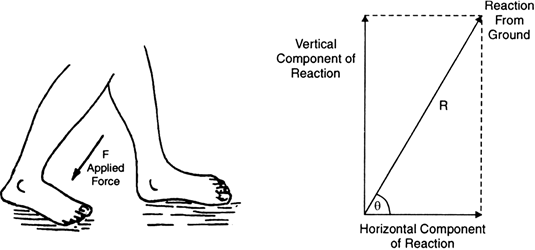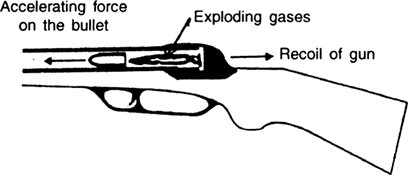Is Matter Around Us Pure
Give some examples to illustrate Newton’s third law of motion.
Illustration's of Newton's third Law of motion:
(i) While walking we press the ground with our feet in the backward direction (action), as shown in Fig. 9.18.
The ground exerts an equal and opposite force on us. The horizontal component of this force of reaction enables us to move forward. 
Fig. Action and reaction force acting while we walk on the ground.
(ii) While swimming, a person pushes water with his hands and feet in the backward direction (action). Water pushes the person with an equal force in the forward direction, which is the reaction force.
(iii) When a gun is fired, the exploding gases, which come out because of a chemical reaction, exert a forward force on the bullet. The bullet exerts an equal and opposite reaction force on the gases. This results in the recoil of the gun, as shown in fig. below

Fig. A forward force on the bullet and recoil of gun.
(iv) When a sailor jumps out of a rowing boat, the boat moves backwards. As the sailor jumps forward, he applies a forward force (action) on boat and the boat moves backwards due to the force of reaction.
Fig. 9.21. As the sailor jumps in forward direction, the boat moves backwards.
Sponsor Area
Some More Questions From Is Matter Around Us Pure Chapter
Which separation techniques will you apply for the separation of the following?
Fine mud particles suspended in water.
Write the steps you would use for making tea. Use the words—solution, solvent, solute, dissolve, soluble, insoluble, filtrate and residue.
Pragya tested the solubility of three different substances at different temperatures and collected the data as given below (results are given in the following table, as grams of substance dissolved in 100 grams of water to form a saturated solution).
|
Substance Dissolved |
Temperature in K |
||||
|
283 |
293 |
313 |
333 |
353 |
|
|
Potassium nitrate |
21 |
32 |
62 |
106 |
107 |
|
Sodium chloride |
36 |
36 |
36 |
37 |
37 |
|
Potassium chloride |
35 |
35 |
40 |
46 |
54 |
|
Ammonium chloride |
24 |
37 |
41 |
55 |
66 |
What mass of potassium nitrate would be needed to produce a saturated solution of potassium nitrate in 50 grams of water at 313 K?
Pragya makes a saturated solution of potassium chloride in water at 353 K and leaves the solution to cool at room temperature. What would she observe as the solution cools? Explain.
|
Substance Dissolved |
Temperature in K |
||||
|
283 |
293 |
313 |
333 |
353 |
|
|
Potassium nitrate |
21 |
32 |
62 |
106 |
107 |
|
Sodium chloride |
36 |
36 |
36 |
37 |
37 |
|
Potassium chloride |
35 |
35 |
40 |
46 |
54 |
|
Ammonium chloride |
24 |
37 |
41 |
55 |
66 |
Find the solubility of each salt at 293 K. Which salt has the highest solubility at this temperature?
|
Substance Dissolved |
Temperature in K |
||||
|
283 |
293 |
313 |
333 |
353 |
|
|
Potassium nitrate |
21 |
32 |
62 |
106 |
107 |
|
Sodium chloride |
36 |
36 |
36 |
37 |
37 |
|
Potassium chloride |
35 |
35 |
40 |
46 |
54 |
|
Ammonium chloride |
24 |
37 |
41 |
55 |
66 |
Pragya tested the solubility of three different substances at different temperatures and collected the data as given below (results are given in the following table, as grams of substance dissolved in 100 grams of water to form a saturated solution).
|
Substance Dissolved |
Temperature in K |
||||
|
283 |
293 |
313 |
333 |
353 |
|
|
Potassium nitrate |
21 |
32 |
62 |
106 |
107 |
|
Sodium chloride |
36 |
36 |
36 |
37 |
37 |
|
Potassium chloride |
35 |
35 |
40 |
46 |
54 |
|
Ammonium chloride |
24 |
37 |
41 |
55 |
66 |
What is the effect of change of temperature on the solubility of a salt?
Explain the following giving examples:
Saturated solution
Explain the following giving examples:
Pure substance
Explain the following giving examples:
Colloid
Explain the following giving examples:
Suspension
Mock Test Series
Sponsor Area
NCERT Book Store
NCERT Sample Papers
Sponsor Area